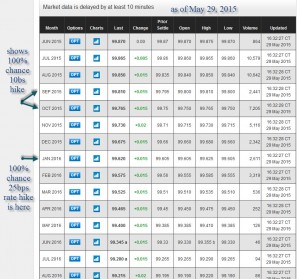As the leading central bank, the Federal Reserve sets policy for the US economy, yet we often see other nations’ central banks pivot off the Fed. This often happens at a slower pace, as countries take an “I’ll wait and see how it works out” approach – but not always. For instance, when the Fed went to a ZIRP (zero interest rate policy) in 2008/09, many central banks aggressively followed and cut their own lending rates to ease money standards. For many, that turned out to be a wise move.
Until lately, the Fed had not considered raising the Fed Funds. At some point, they knew they’d have to raise rates due to inflation (of prices or assets). From 2009 until mid-2014, I had no interest in looking at the Fed Funds Futures, as the Federal Reserve Committee had no interest in moving rates from zero. (The policy was considered temporary, but without an expiration date.)
In mid-to-late 2014, we started seeing some movement in futures, because the “When will the Fed raise rates?” guessing game was on. It is important to note that the Fed has never been shy about rhetoric; they choose their words carefully and wait to see how the market will respond. Remember back in May/June 2013 when then Fed Chairman Ben Bernanke floated the idea of reducing Fed purchases of treasury securities? That caused the first “taper tantrum,” so the Fed dialed it back. The market response was important – it took a nose dive in subsequent days – as it clearly showed the fragility of market psychology.
So, flash forward to today. We are certainly closer to rate hikes now than we were a year ago. The futures market tells us this fact. The question now is not if but when – and how much. Further, the planned  incremental moves could have a big effect on the economy. Traditional rate hikes have been 25bps to 75bps (raise or cut). But recent “Fedspeak” has indicated they would prefer a very slow pace of rate increases. Does that mean 10bps?
incremental moves could have a big effect on the economy. Traditional rate hikes have been 25bps to 75bps (raise or cut). But recent “Fedspeak” has indicated they would prefer a very slow pace of rate increases. Does that mean 10bps?
That could very well be the case, and it would be in line with a gradual approach. Everyone expects a rate hike at the September meeting, and interestingly enough, the futures market has priced in a 100% chance of a 10bps rate hike (see graph). This would likely be a nice compromise to satisfy everyone.
Note that the market is also betting on a 100% chance of a 25bps rate hike by January. Please remember that the Fed will not just raise rates for some symbolic reason. If inflation expectations start to rise, then rate increases should act as the neutralizer. (We will learn more about these expectations with a revised forecast following the June meeting in two weeks.) Let’s also not forget that the financial crisis set up unprecedented action and policy moves for the Fed, and while it has achieved all of their goals, it certainly helped the economy sidestep a disastrous outcome.
I’d also like to point out something else of interest: With the markets already expecting this sort of tightening, the Fed may have let the market do its work for them. This could be the ideal situation – no one will be caught off guard. Taper tantrums aside, this is a very important moment for the Fed and markets. They have been good stewards of policy so far; let’s hope that continues when the time is right for a policy pivot.



















